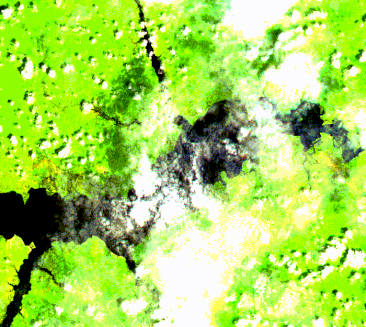- Home
- :
- All Communities
- :
- Industries
- :
- Imagery and Remote Sensing Insights (IRIS) COP
- :
- Imagery Blog
- :
- Environmental Monitoring with Synthetic Aperture R...
Environmental Monitoring with Synthetic Aperture Radar
- Subscribe to RSS Feed
- Mark as New
- Mark as Read
- Bookmark
- Subscribe
- Printer Friendly Page
The Value of SAR
Synthethic Aperture Radar, or SAR for short, has a reputation for being an unintuitive, complex, and a niche Earth observation technology that is only used by researchers. While this may be true to an extent, SAR data allows analysts to monitor remote environments persistently that would be otherwise impossible through optical satellite sensors. This is extremely important and valuable in places such as the Amazon Rainforest or Alaska, where traditional optical satellites are obstructed by constant cloud coverage.
Sentinel-2 time-series over Acre, Brazil from Jan - July 2021 Sentinel-1 time-series over Acre, Brazil from Jan - July 2021
Due to SAR sensor characteristics, imagery can be acquired over an area of interest regardless of the time of day and weather conditions.
To read more about how SAR sensors work, read this documentation: Introduction to Synthetic Aperture Radar
Monitoring Change in the Amazon Rainforest
The amazon rainforest is one of the world's important biological reservoirs, containing 1/3 of the world's species, 1/4 of the world's freshwater, and ~50 billion tons of carbon dioxide in it's trees. While the Amazon is important, it also also constantly under threat of deforestation. Remote sensing techniques such as change detection are key in understanding any change that occurs in the region. However, as we can see from the Sentinel-2 time-series animation above, data is not always persistent and reliable as clouds obscure optical satellite views. So while you might be able to get an image on any given day, valuable time can be lost waiting for another cloud-free image.
SAR data is highly available publicly and through commercial content providers such as ICEYE and Capella Space. With SAR imagery, analysts can monitor intra-weekly change to potentially lead to faster ground response efforts. For example here are two SAR images over Acre, Brazil just 3 days apart.


SAR images are 2d renderings of the backscatter signal returned to the SAR sensors. While this backscatter image is sensitive to a wide variety of changes that occur on the Earth's surface, it can difficult to visually spot where change is occurring. However, calculating a log ratio between two images can assist in monitoring efforts, visually highlighting where change in the scene occurs.
In this short demo, analysts can user a Raster Calculator function to do a log ratio change analysis. T1 denotes the reference image (oldest acquisition) while T2 denotes the comparison image (most recent acquisition). The result will be a gray scale raster that usually ranges 2 to -2.
Immediately, we can visually see where change has occurred in the scene and only three days apart! Gray tones denote minimal change, whilst white and black tones denote an increase and decrease in backscatter, respectively. Furthermore, we could classify the pixels to understand more complex change dynamics and quantify change occurring in the Amazon Rainforest. The image below is the same analysis as above with a log ratio between the average backscatter values across the month of March in 2022 and 2023, and classifies the raster to quantify deforestation.
SAR data can be complex, but with ArcGIS Pro it can be a valuable aid to monitoring and response efforts with persistent monitoring capabilities. For any questions please email jperez@esri.com.
You must be a registered user to add a comment. If you've already registered, sign in. Otherwise, register and sign in.
-
Analysis
9 -
ArcGIS Drone2Map
3 -
ArcGIS Excalibur
1 -
ArcGIS Image Analyst
2 -
ArcGIS Image for ArcGIS Online
1 -
Change detection
1 -
Deep learning
3 -
Elevation and lidar
6 -
Image management
2 -
Image Mapping
8 -
Image Services
2 -
Imagery
1 -
Mosaic datasets
1 -
Motion imagery
5 -
Oriented Imagery
2 -
Raster functions
1 -
Site Scan for ArcGIS
1 -
Visualization
8
- « Previous
- Next »




